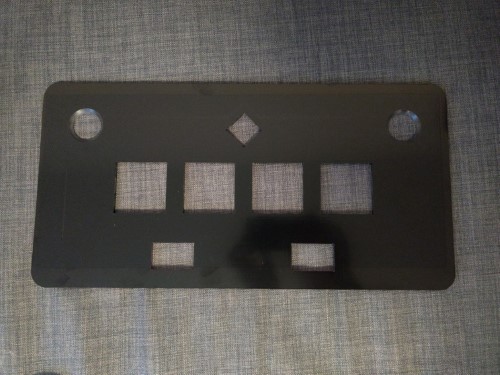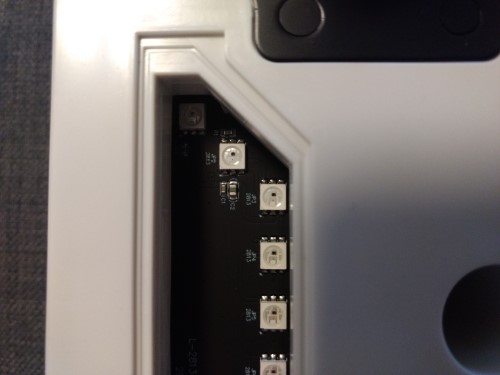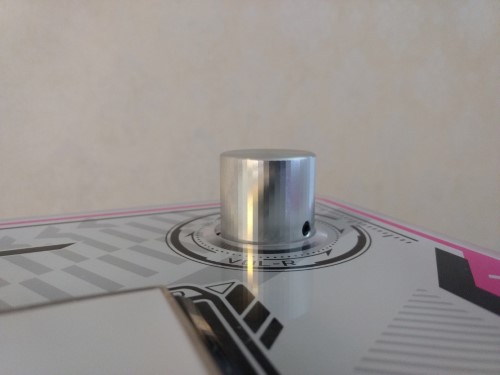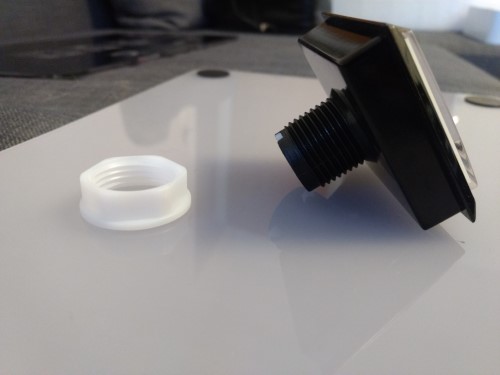FauceTwo Review
Last updated: 2021-06-04
Disclaimer: DJ DAO sent me the controller, for me to keep, free of charge for review and USC support.
Unboxing
The controller comes in a pretty high quality box with good enough foam that the risk of damage during shipping should be minimal.
In the box there are:
- 1x controller
- 1x USB-A to USB-B Cable
- 1x USB-A to USB-C Cable
- 10x Damping sheets for the knobs
- 1x Product Manual
The damping sheets are found in the small blue box besides the cables. The sheets are used to adjust the knob turning resistance.
Set-up
The controller is just plug-and-play and will show up as either F2 HID or
F2 eAclould
depending on which mode it is in.
Setting up the controller in USC or KSM is the same procedure as any other controller and the sensitivity
value that
I found to work well
in USC is around 4.0.
You connect the controller using two USB cables, one USB-B and one USB-C. Only the USB-B cable needs to be connected for the controller to function but the RGB lights are powered by the USB-C connection so that has to be plugged in for the lights to light up. The USB-C cable does not need to be connected to a PC, it can be connected to anything that delivers more than 1Amp so even a power bank will work.
The FauceTwo also has a deadzone feature where it can be set to ignore very small knob movements. You adjust the deadzone by holding the function button and then FX-L to decrease or FX-R to increase. I think that you should use the lowest setting when you can but if you are having trouble with the knobs moving due to vibrations from button hits then you can try increasing it.
It also features HID controllable lights, while these are unsupported by a lot of software, USC has experimental support available at https://builds.drewol.me/feat/lightplugin/Game but the support should make it to the normal version in the near future.
Modes
The controller has three different modes, the mode can be switched by holding
FXL + FXR + START + BTx
where BTx depends on which mode you want.
The modes are:
- BTA: e-Amusement Cloud Mode. The controller should work natively with SDVX Cloud in this mode but I have not tested this yet.
- BTB: HID Mode. The controller appears as a standard gamepad with X/Y-axis knob input. This is the mode you should use for most things that aren’t e-Amusement Cloud.
- BTC: Mouse + Keyboard Mode. The controller sends keyboard presses for buttons and moves the mouse with
the
knobs. In my opinion this mode should really only be used if the other modes do not work.
- Bindings:
- BT A/B/C/D:
d/f/j/k - FX L/R:
c/m - Function:
F2 - Knob L/R:
Mouse X/Mouse y
- BT A/B/C/D:
- Bindings:
Playing
While I do not play at the highest level, I play at around level 16 to easier 17, my experience with the FauceTwo has been quite pleasant. For reference my previous controller experience is an older SVSE5, a pocket voltex, and I have also spent some time playing at the arcade on a real machine. It took practically no time to get used to the FauceTwo as it has arcade accurate distances between the buttons and the knobs, with an exception for the start button.
When I first learned that the case was made of plastic I was concerned that it would make the controller so light that it would slide around during play. But the controller is heavy enough that with its rubber feet it sits firmly in place while playing.
The knobs have a feeling that I would say is close to that of many popular optical encoders such as the Copal encoders used in the SVSE5. This more free-spinning knob feeling is not my preffered one but it did not affect my playing in any negative way.
The buttons that my controller shipped with are DJ DAO custom buttons with 60g springs and omron 50g switches (1C3). The buttons have not shown any tendency to get stuck and the feeling is consistent. In my opinion these buttons will not affect your playing performance compared to sanwa buttons as they feel pretty close, but not the same. The more important factor in button feeling is the combination of spring and switch weights, my ideal setup would probably use a lighter spring and heavier switches but that is all up to personal preference.
Maintenance
To service the controller you need to take of the bottom panel to access the internals. The bottom panel is held on by magnets so no tools are required to disassemble most of the controller, the knob encoder mounting is secured by screws so to fully disassemble the controller you will need screwdrivers and an allen key.
The magnets that keep the bottom in place are not as strong as the magnets used in my SVSE5, which almost needs to be pried open, but they are definitely strong enough so that it will not come off by accident.
The controller ships with replacement damping sheets for the knobs and the instruction manual says to replace these every 3-4 months, since I have not used the controller for that long I cannot say how accurate this is and in what way the knob feeling changes over time. The manual also says to clean the insides of the buttons every 2-3 months to make sure there’s no gunk making the buttons rebound slower.
Construction
Case
The case is entirely made out of plastic, this makes the controller quite lightweight which is nice for transport. I do not know which production method or type of plastic is used to make the case though it does feel pretty sturdy. One thing I know of from other hard plastic things is that they have a risk of shattering but I do not know what that risk is with the FauceTwo and I do not want to test the limits myself so that is something that the manufacturer will have to say themselves.
And as with most controllers there’s a clear acrylic panel on top with the artwork printed directly on it, so there’s no way to use your own artwork at the moment.
PCB
The PCB appears to be a new one from DJ DAO and it looks like it could support many other games with the amount of unconnected headers available, but I cannot say for sure. The firmware that it ships with is quite adequate which is not something I have been able to say for most controllers I know of except for the pocket voltex which also has a very good default firmware.
Encoders and Knobs
The encoder is no longer a standard optical rotary encoder like a Copal, instead it uses a metal encoder disc with photointerrupters. I do not know the reason for this change but I do not think that most users will notice a difference in performance. My first impression is that this solution should be more durable than an enclosed solution like the Copals which often gets described as not very durable.
The knobs themselves are metal and are of the same dimensions as the SVSE5 knobs, which I believe is the same as arcade, with a diameter of 3cm and a height of 2.5cm. However unlike the SVSE5 knobs, which are perfectly round, the FauceTwo features faceted knobs which is something that makes them a bit closer to arcade knobs.
Buttons
DJ DAO custom buttons, nothing new, perfectly fine, but not sanwa.
Conclusion
My thoughts on the FauceTwo are that it’s a very good option for those who are looking for a mid-sized arcade
style
controller, if the price is right. As of writing this the pricing and configurations are unknown.
The price for the standard configuration is $169US and with omron switches (what I got) it's $199US (shipping not included) which I think is a very fair price for this controller.
The PCB and firmware the controller ships with seems very adequate which is not something I can say for some other controllers.
There are some things that I can see being issues, but from my short time with the controller these things appear to be fine. The durability of the case seems good to me but not all plastics are created equally. Also it’s a bit too early for me to make a statement on the durability of the knob encoders. I do also not know how much the knob feeling is adjustable but while what it ships with is not my personally preferred feeling it does not really have an impact on playing performance which is good.
DJ DAO does offer full replacements for things damaged during shipping so if something is broken when the controller arrives you will be able to get it replaced for free.
The button weights that my controller shipped with are also not what I like the most but that is also up to personal preference and it’s usually something you can choose when ordering the controller.






























